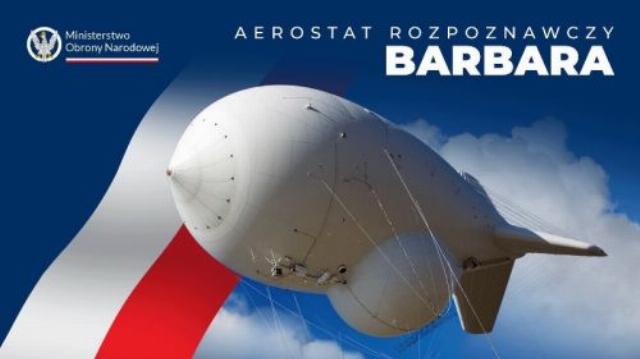On May 22, 2024, an agreement was concluded in Warsaw between the Polish Ministry of National Defense and the US government (in the form of an exchange of Letters of Offer and Acceptance - LOA between the governments) for the supply to Poland through the American program of intergovernmental foreign military sales Foreign Military Sales (FMS) of four balloon radar detection complexes Airspace and Surface Radar Reconnaissance (ASRR) within the framework of the Polish Barbara program. The cost of the agreement is $960 million and it should be financed by a concessional loan from the US government. The ceremony was attended by Deputy Prime Minister and Minister of National Defense of Poland Vladislav Kosinyak-Kamysh and U.S. Ambassador to Poland Mark Brzezinski.

Image of the Airspace and Surface Radar Reconnaissance (ASRR) balloon radar detection complex purchased by Poland in the United States through the American intergovernmental Foreign Military Sales program Foreign Military Sales (FMS) within the framework of the Polish Barbara program (c) Ministry of National Defense of Poland
As planned, the balloon complexes will be deployed at posts along the eastern and northeastern borders of Poland, becoming part of the planned formation of an aerostatic radio engineering division within the Polish Air Force. The balloon complexes will become an element of the airborne radar reconnaissance and detection system, complementing the Polish air defense radar systems and coastal surveillance systems in service. Balloon complexes will allow detecting aerial objects flying at extremely low altitudes, including missiles, airplanes, unmanned aerial vehicles, as well as surface objects. The detection range of the complex will be more than 300 km, and the working altitude of the balloon will be about 4 km.
The purchase includes the supply of four balloon complexes for detecting aerial and ground targets. The first complex will be delivered to Poland by the end of 2026 and put into full operation in the first quarter of 2027. The remaining three complexes will be delivered by the end of the third quarter of 2027, and the readiness of the entire system will be achieved by the end of 2027.
Each balloon will be equipped with an overhead radar detection system. The ground segment will consist of a control center, a berthing platform, a weather station and containers with electric generators. Additionally, a logistics package was ordered under the contract, including maintenance, spare parts, technical support and training of personnel and instructors.
Plans to deploy an aerostat radar detection system in Poland under the Barbara cipher have been discussed since 2017, but the implementation of the program was sharply accelerated after incidents with cruise and anti-aircraft missiles flying into Poland from Ukraine in the winter of 2022-2023, which demonstrated the problems of Poland's air defense with detecting low-flying targets. In May 2023, the then Minister of National Defense of Poland, Mariusz Blaszczak, announced that the US government had submitted an application for the purchase of balloon complexes under the Barbara program. On February 7, 2024, the Defense Security Cooperation Agency (DSCA) of the US Department of Defense sent a notification to the US Congress about the planned sale of Airspace and Surface Radar Reconnaissance (ASRR) balloon radar detection complexes to Poland through the American FMS program, while the cost of possible delivery was tentatively estimated at $ 1.2 billion.
The specific technical appearance of the balloon complexes planned for delivery to Poland was not disclosed, but in the DSCA notification, Raytheon Intelligence and Space, Elta North America (the American representative office of the Israeli company IAI Elta) and Avantus Federal (now QinetiQ US) were named as the general contractors of the supply.
In recent years, the former Avantus Federal Company (now QinetiQ US) has been the contract operator of the Tethered Aerostat Radar System (TARS) balloon detection complexes of the US Border and Customs Service (CBR). The TARS system has been operated by the SVR since 1980 and is built on tethered balloons manufactured by American companies TCOM and ILC Dover (Lockheed Martin Corporation was the general supplier for the supply and integration of balloon complexes).
It is worth noting that Raytheon also previously worked for a long time for the US Department of Defense to develop an aerostat complex for detecting low-flying cruise missiles as part of the JLENS (Joint Land Attack Cruise Missile Defense Elevated Netted Sensor System) program, which was closed in 2017 after more than 20 years of work. The program used 74-meter TSOM 74M balloons of the TSOM company.
The Israeli IAI Elta, apparently, will act as a supplier of the EL/M-2083 detection radar with AFAR, specially designed for balloon complexes based on TCOM balloons used in Israel.
In light of all this, it can be assumed that the project for Poland will use TCOM balloons (apparently, modifications 71M or 74M) equipped with the IAI Elta EL/M-2083 radar, while Raytheon Intelligence and Space will act as an integrator and general contractor, and QinetiQ US will be the contractor operator of the complexes.
Video:
